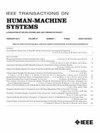Fuzzy Adaptive Controller of a Wearable Assistive Upper Limb Exoskeleton Using a Disturbance Observer
IF 4.4
3区 计算机科学
Q2 COMPUTER SCIENCE, ARTIFICIAL INTELLIGENCE
引用次数: 0
Abstract
The motivation behind the development of a wearable assistive upper limb exoskeleton robot was to provide comprehensive multijoint therapy by assisting physiotherapists in enhancing the recovery of hemiplegic patients. However, the controlling of an upper limb exoskeleton for rehabilitation is a challenging task because of its nonlinear characteristics. This article presents a novel fuzzy adaptive controller that utilizes a high-dimensional integral-type Lyapunov function for a wearable assistive upper limb exoskeleton. A disturbance observer had been used to tackle uncertainties in the exoskeleton's dynamic model, thereby enhancing the tracking performance of the joints. The aim of this control scheme was to overcome unknown parameters in the dynamic model. The performance of the adaptive controller was validated through human interactive experiments and periodically repeated reference trajectory tests. The results demonstrated that the proposed fuzzy adaptive controller, with the inclusion of a disturbance observer, could effectively compensate for uncertain disturbances and could achieve efficient tracking of the reference trajectory. The statistical analysis revealed that the fuzzy adaptive controller performed 45%, 44%, and 31% less in average error compared to adaptive conventional controllers. The findings ascertained the potential of the proposed controller in improving the recovery of motor functions of hemiplegic patients.基于扰动观测器的可穿戴辅助上肢外骨骼模糊自适应控制器
开发可穿戴辅助上肢外骨骼机器人的动机是通过帮助物理治疗师加强偏瘫患者的康复来提供全面的多关节治疗。然而,由于上肢外骨骼的非线性特性,其康复控制是一项具有挑战性的任务。本文提出了一种新的模糊自适应控制器,该控制器利用高维积分型Lyapunov函数用于可穿戴的辅助上肢外骨骼。利用扰动观测器处理外骨骼动力学模型中的不确定性,从而提高关节的跟踪性能。该控制方案的目的是克服动态模型中的未知参数。通过人机交互实验和周期性重复参考轨迹测试,验证了自适应控制器的性能。实验结果表明,引入干扰观测器的模糊自适应控制器能够有效补偿不确定性干扰,实现对参考轨迹的有效跟踪。统计分析表明,与自适应传统控制器相比,模糊自适应控制器的平均误差分别降低了45%、44%和31%。研究结果确定了所提出的控制器在改善偏瘫患者运动功能恢复方面的潜力。
本文章由计算机程序翻译,如有差异,请以英文原文为准。
求助全文
约1分钟内获得全文
求助全文
来源期刊

IEEE Transactions on Human-Machine Systems
COMPUTER SCIENCE, ARTIFICIAL INTELLIGENCE-COMPUTER SCIENCE, CYBERNETICS
CiteScore
7.10
自引率
11.10%
发文量
136
期刊介绍:
The scope of the IEEE Transactions on Human-Machine Systems includes the fields of human machine systems. It covers human systems and human organizational interactions including cognitive ergonomics, system test and evaluation, and human information processing concerns in systems and organizations.
 求助内容:
求助内容: 应助结果提醒方式:
应助结果提醒方式:


